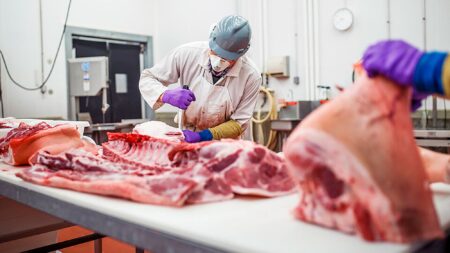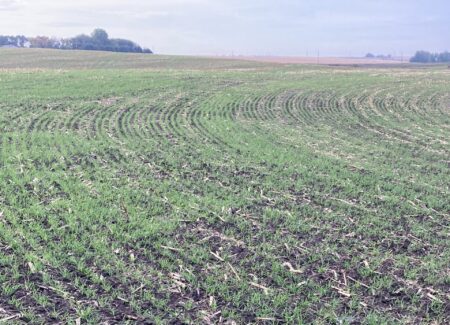According to USDA’s most recent Crop Progress report, the oat crop across the country’s top oat-growing states was rated 47% good-to-excellent the week ending May 11. A year ago, that percentage was 63%.
The nine leading oat-producing states are experiencing varied conditions, with positive ratings in some areas being offset by lower ratings in others. For five states, at least 79% of the respective oat crop was rated good-to-excellent. For the remaining four, that percentage ranges from just 13% to 41%.
Here’s a closer look at the numbers.
Pennsylvania
The state with the highest rated oat crop is Pennsylvania. As of May 11, 88% of the state’s oat crop was in good-to-excellent condition. Overall, oats were rated 8% excellent, 80% good, 10% fair, 1% poor, and 1% very poor.
According to USDA’s March Prospective Plantings report, Pennsylvania farmers are expected to grow 60,000 acres of oats this year. The state’s oat crop was 80% planted and 48% emerged by May 11.
Wisconsin
The Badger State had the second highest rated oats— 87% of the crop was rated good-to-excellent. Overall, Wisconsin’s oats were rated 23% excellent, 64% good, and 13% fair. None was rated poor or very poor.
Wisconsin farmers are expected to grow 165,000 acres of oats this year. The state’s oat crop was 62% planted and 23% emerged by May 11.
Iowa
Oats are looking almost as favorable in Iowa, where 85% of the crop was in good-to-excellent condition the week ending May 11. Overall, oats were rated 17% excellent, 68% good, 14% fair, 1% poor, and 0% very poor.
Iowa farmers are expected to grow 150,000 acres of oats this year. The state’s oat crop was 97% planted and 74% emerged by May 11.
Minnesota
In Minnesota, the oat crop was rated 79% good-to-excellent. Overall, 6% was rated excellent, 73% was rated good, 19% was rated fair, 1% was rated poor, and 1% was rated very poor.
Minnesota farmers are expected to grow 195,000 acres of oats this year. The state’s oat crop was 72% planted and 34% emerged by May 11.
Ohio
The oat crop in the Buckeye State was also rated 79% good-to-excellent. Overall, Ohio’s oat crop was rated 4% excellent, 75% good, and 21% fair. None of the crop was rated poor or very poor.
Ohio farmers are expected to grow 60,000 acres of oats this year. The state’s oat crop was 82% planted and 67% emerged by May 11.
North Dakota
For the remaining states, oat crop condition dropped off significantly.
In North Dakota, the combined percentage of oats rated good-to-excellent was just 41% the week ending May 11. North Dakota’s crop overall was rated 1% excellent, 40% good, 54% fair, 4% poor, and 1% very poor.
North Dakota farmers are expected to grow 300,000 acres of oats this year. The state’s oat crop was 55% planted and 18% emerged by May 11.
South Dakota
Only 33% of the oat crop in South Dakota was rated good-to-excellent. The breakdown in overall conditions was 5% excellent, 28% good, 52% fair, 9% poor, and 6% very poor.
South Dakota farmers are expected to grow 290,000 acres of oats this year. The state’s oat crop was 94% planted and 65% emerged by May 11.
Nebraska
The oat crop in Nebraska was the second worst of the top oat-growing states: just 24% was rated good-to-excellent. Overall, 2% was rated excellent, 22% was rated good, 46% was rated fair, 16% was rated poor, and 14% was rated very poor.
Nebraska farmers are expected to grow 130,000 acres of oats this year. The state’s oat crop was 93% planted and 77% emerged by May 11.
Texas
Finally, Texas had the worst rated oats across top states. The oat crop in the Lone Star State was rated only 13% good-to-excellent. Overall, 2% was rated excellent, 11% was rated good, 42% was rated fair, 24% was rated poor, and 21% was rated very poor.
Texas farmers are expected to grow 340,000 acres of oats this year. The state’s oat crop was 100% planted and 100% emerged by May 11.


:max_bytes(150000):strip_icc()/Markets-farm-clouds-yellow-6f989151bdbd42fa8819fa715cfbe6f3.jpeg)
:max_bytes(150000):strip_icc()/102002175_soybeans-997c7582d12d4962b1af64e7a1885a46.jpg)



:max_bytes(150000):strip_icc()/8496689585_8e8be851ae_o-50cfb3ce212e4734bddd75041650b032.jpg)


:max_bytes(150000):strip_icc()/rfs-kim-reynolds3-1024x683-ef170b83d44c4d4eb45f03b2f5e367a1.jpg)
